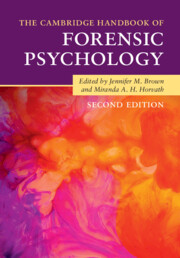Book contents
- The Cambridge Handbook of Forensic Psychology
- The Cambridge Handbook of Forensic Psychology
- Copyright page
- Dedication
- Contents
- Figures
- Tables
- Contributors
- Preface
- Forensic Psychology
- Part I Psychological Underpinnings
- Part II Psychology and Criminal Behaviour
- 2.1 Current Understandings of Sex-Based Harassment and Stalking Perpetration
- 2.2 The Behaviour of Sex Offenders
- 2.3 Intimate Partner Violence
- 2.4 Acquisitive Crime
- 2.5 Terrorism Research
- 2.6 Online Child Sexual Exploitation and Abuse
- 2.7 Arson
- 2.8 Serial Killings and Mass Murder
- Part III Assessment
- Part IV Interventions
- Part V Civil Proceedings
- Part VI Professional Practices
- Index
- References
2.5 - Terrorism Research
Current Issues and Debates
from Part II - Psychology and Criminal Behaviour
Published online by Cambridge University Press: 02 December 2021
- The Cambridge Handbook of Forensic Psychology
- The Cambridge Handbook of Forensic Psychology
- Copyright page
- Dedication
- Contents
- Figures
- Tables
- Contributors
- Preface
- Forensic Psychology
- Part I Psychological Underpinnings
- Part II Psychology and Criminal Behaviour
- 2.1 Current Understandings of Sex-Based Harassment and Stalking Perpetration
- 2.2 The Behaviour of Sex Offenders
- 2.3 Intimate Partner Violence
- 2.4 Acquisitive Crime
- 2.5 Terrorism Research
- 2.6 Online Child Sexual Exploitation and Abuse
- 2.7 Arson
- 2.8 Serial Killings and Mass Murder
- Part III Assessment
- Part IV Interventions
- Part V Civil Proceedings
- Part VI Professional Practices
- Index
- References
Summary
This chapter sets out the field of terrorism studies and reviews the main issues and research directions that characterise the field today. The history of the discipline is summarised and terrorism and its ‘near neighbour’ hate crime are defined and compared before turning to the developments that have dominated the research agenda over the last ten years.
- Type
- Chapter
- Information
- The Cambridge Handbook of Forensic Psychology , pp. 261 - 278Publisher: Cambridge University PressPrint publication year: 2021



